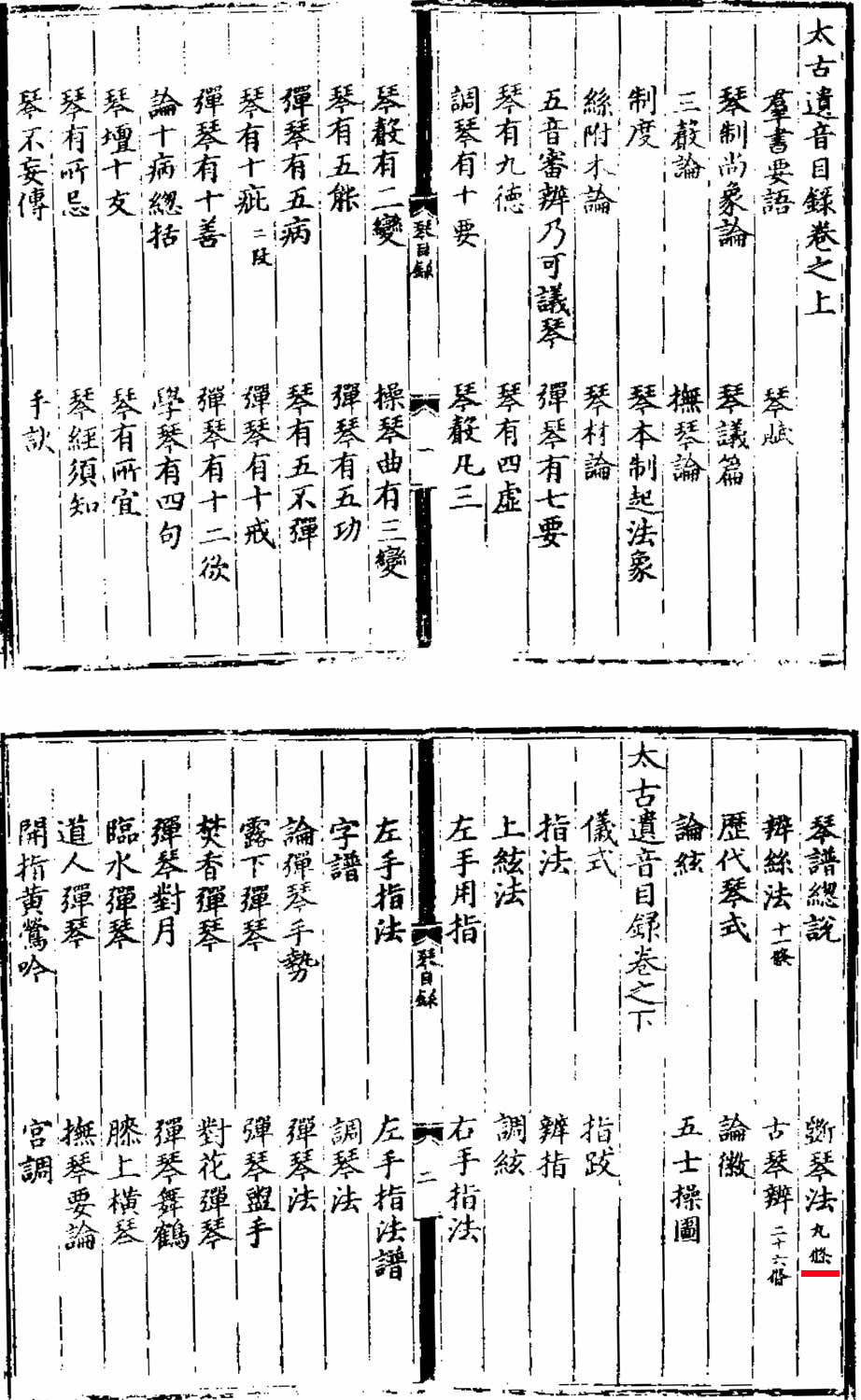|
T of C
Home |
My Work |
Hand- books |
Qin as Object |
Qin in Art |
Poetry / Song |
Hear, Watch |
Play Qin |
Analysis | History |
Ideo- logy |
Miscel- lanea |
More Info |
Personal | email me search me |
| TYDQJ | 首頁 |
|
Taigu Yiyin
|
太古遺音
Page 1 (QQJC I/25): Table of Contents1 |
 Most of the information in this handbook was later included in
Taiyin Daquanji, translations from which are linked from here. It is the
third such handbook discussed in
this article by
Tong Kin-Woon.
Most of the information in this handbook was later included in
Taiyin Daquanji, translations from which are linked from here. It is the
third such handbook discussed in
this article by
Tong Kin-Woon.
Preface, by Zha Fuxi2
from Qinqu Jicheng, Vol. I, p. iv
3
(Beijing, Zhonghua Shuju Chuban Faxing, 1981 (printed in Shanghai)
In the collection of the Beijing Library, (this is) a printed volume from the Ming dynasty; the editor and selector's name is not given. This book should have two folios, but now there is only a fragmentary edition with the first folio. At the front there is no preface. According to what Zhu Quan wrote in his preface, dated 1413, to Xinkan Taiyin Daquanji, Taigu Yiyin was originally compiled by Tian Zhiweng of the Song dynasty, and he counted three folios.
During the Southern Song Jiading reign (1208-25), Yang Zuyun changed the name (of Tian Zhiweng's book) to Qinyuan Xuzhi, and presented this to the imperial court. During the Ming dynasty Yongle reign (1403-25) Zhu Quan obtained this at Tuyang.4 Later, arriving in the Jiangxi region,5 based on various different editions he had obtained, he made corrections, "removing the useless parts, patching up the missing parts, arranging it as two folios, and calling it Taigu Yiyin." The present fragmentary Taigu Yiyin, as luck would have it, also has two folios; and the heading "Ten Friends of the Qin Hall" doesn't have the words Emaciated Immortal in front.6 If you look from the standpoint of these two items, this (later) book was perhaps a revised edition by Zhu Quan. However, the style of this editor was not very rigorous. For example, between the sections "Structure of the underside of a qin" and "The basic nature of a qin gives rise to certain shapes" for no good reason there is the insertion of a segment with finger technique material of (Tang) Zhao Yeli;7 this segment is not in the table of contents. It is hard to believe that this sort of disorderly and unsystematic method could come from the hand of the famous scholar Zhu Quan. According to Yuan Junzhe's "Summary introduction to Taiyin Daquanji",8 when he discusses the mother editions he used as a basis, he also only says, "The current day's so-called Taigu Yiyin collection", and doesn't say the editor of (his? any?) Ming edition was Zhu Quan. From this one can infer that perhaps this book came from the booktrader's own hands.
The valuable point of this book is that it is the oldest surviving edition of Taigu Yiyin. From looking at its table of contents, (the complete volume would) preserve not a few long-lost qin writings and qin tablature from the Tang and Song dynasties. See for example such qin pieces as Golden Oriole Intonation, which is in Shilin Guangji; the recording of 22 segments in the left hand section of "Diagrams (explanations?) of Hand Signs"; and so forth.9 For researching the origin and development of the book Taiyin Daquanji, and for determining the validity of historical materials, these all have relatively important value.
Footnotes (Shorthand references are explained on a
separate page)
1.
Image: Page 1 (QQJC I/25): Table of Contents
The edition here has a complete table of contents but the book itself is not complete: it ends after four of the nine-subsections of "斵琴法 Zhuo Qin Fa" (see the red mark in the image, at top. As an indication of how the differing editions of this book had differing arrangements of this material, note that this 斵琴法 Zhuo Qin Fa appears at the beginning of Taiyin Daquanji, where it is called
造琴法度 Zao Qin Fadu.
(Return)
2. 查阜西 Zha Fuxi; edited for publication by 吳釗 Wu Zhao (Return)
3. Here Roman numerals are used for the introductions and Arabic numerals for the pages with reprints. The Chinese original uses Chinese numbers for both. (Return)
4. There was a Tu river flowing through Zhu Quan's old commandery at Daning; the next phrase makes this region a reasonable guess. But being north of the Great Wall, it was perhaps an unlikely spot for old music books. There is also a town named Fengyang near the famous Mount Tu, about 200 km northwest of Nanjing, in Anhui province; perhaps it was near here. (Return)
5. "area east of the Yangzi, now called Jiangxi", the capital of which was Zhu Quan's own principality, Nanchang. (Return)
6. Compare Qinqu Jicheng, Vol. I, p. 30 (top right), with p. 39 (top left); the latter has the same lists but adds explanation (yinshi ) to each; Zhu Quan called himself the Emaciated Immortal. (Return)
7.
Finger techniques 指法
Compare the Taigu Yiyin finger techniques (QQJC, Vol. I, pp. 24 and 25) with those in Taiyin Daquanji (ibid., p.79ff), which give as their source 劉籍 Liu Ji's 琴議 Qin Yi. Part of Qin Yi is also in QSDQ).
(Return)
8. Ibid., Vol. I, p. 35; Yuan Junzhe lived during 1436-50, but the surviving edition was published during 1506-22. (?) See also the preface to this book. (Return)
9. Shilin Guangji dates from the Southern Song; see Vol. I, pages 12f. (Return)
Return to Taiyin Daquanji index page,
to the annotated handbook list
or to the Guqin ToC.